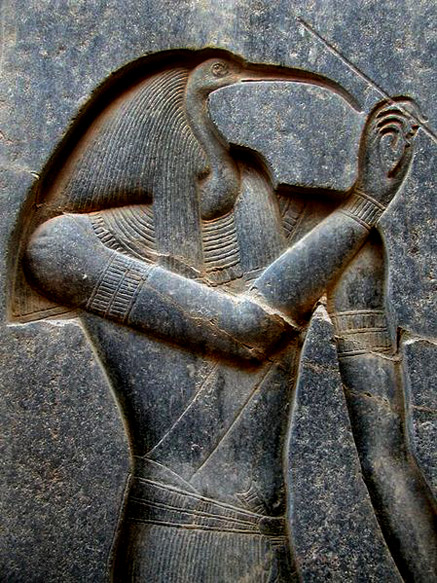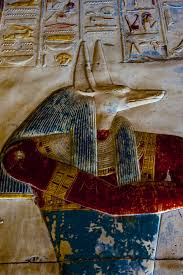Ancient Psychedelia: Alien Gods & Mushroom Goddesses
Online Book - Chapter 10, Page 166
Back to Online Book Mainpage / Next Page (Chapter 10, Page 167)
 (33h) Sunken relief of Thoth Luxor Temple c. 1400 BC  (32f) Anubis from the Temple of Seti I c. 1290-1279 BC Later attributions as the founder of medical science were assigned to Thoth, the ibis-headed deity. A piece of Lapis Lazuli was found from the 5th millennium BC, with a legend engraved on it for the use of the dead which reads: “I am Thoth, the inventor and founder of medicines and letters; come to me, those that are under the earth, rise up to me, thou great spirit.” (73) During the latter Graeco-Roman period Thoth became fused with Hermes Trismegistos. (74) Thoth was also a great protector against evil and especially illness and was summoned upon for this purpose, “My god Thoth is a shield round about me.” (75) The invocations for the gods and goddesses served the purpose of ridding the body and mind of demons of various sorts, or evil goddesses and gods. This was alleviated by taking drugs and herbal concoctions. The demon was thought to be an evil spirit which could be rid by the help of a good god, by taking a plant spirit along through ingestion. This next paragraph quote reveals how this was supposed to work, and for what purpose Ra and Thoth were invoked. (76) |
“I have come forth from On, with the great ones of the palace, the lords of protection. The rulers of eternity, who protect me, I have come forth from Sais with the mother of the gods. They have given me their protection (consisting of) charms which the Lord-of-all made to drive out the is-t-c (??) of the god and the goddess, the male death, the female death, etc., which is in this my head, in this my shoulder, in this my body, in these my members, in order to punish the Xr/zy (??)-demon the leader of those who cause illness and bibi to enter these my members. I belong to Ra. I say: I protect him against his enemies. His leader is Thoth who has caused the manuscripts to speak and has made the book. He gives glory to the learned, to the physicians his servants, in order to protect him whom his god wishes to preserve. … The words are to be spoken on the application of a remedy to any member which is ill. Excellent and true, (tested) a million times.” (77) This next section reveals where the idea of the Jinn (demons of the Koran) come from and we find that Thoth is also the “Physician of the Eye of Horus”: “The word for the oil, for any prescription: Greeting to thee, O Horus eye, Ra gave arms to her before the nine gods. Isis, the Goddess, came forth after she had shouted before Geb. She fought for her, etc. Protect him from the Jin(J)-t, the male and the female death. I am this Thoth, this physician of the eye of Horus. My father Osiris fights before Nut, lord of life and her attendants. For we have protected, etc.” (77) Demons of disease in Hinduism went by many names including raksas (‘injurer’), atrin (‘eater’), and pisachas, though the identity of this last one remains unknown. (78) Amulets were commonly worn for protection against evil spirits and were considered “god-born” with many of them incorporating elements of the vegetable kingdom along with metals, precious stones, strings and knots. (79) A number of figurine amulets found throughout Egypt depicting Thoth are supposed to refer to his functions as a healer and magician. (80) He had a primitive shrine at Hierakonpolis, and his first sanctuary was at Hermopolis which became the greatest healing temple in ancient Egypt. There was a medical school and library connected with it of which contained forty-two Hermetic books of Thoth which were discovered there, six of which were medical. These are probably the same texts mentioned by Clement of Alexandria as the “Texts of Hermes.” (81) (73) Budge, Magic, p. 43 (74) Griffith, Stories of the High Priests of Memphis, p. 58 (75) Anastasi Papyrus, I, viii, 3 (76) Healing Gods, p. 81 (77) Univ. CA. Publications Egyptian Archaeology, Vol. I The Hearst Medical Papyrus Hieratic Text (78) Healing Gods, p. 152 (79) ibid, p. 158 (80) ibid, p. 81; Boylan, P., Thoth, the Hermes of Egypt, Oxford, 1922, p. 131 (81) ibid, p. 82-83; Wilkinson, Manners and Customs of the Ancient Egyptians, Vol III, p. 171 |
Go Back to Page 165